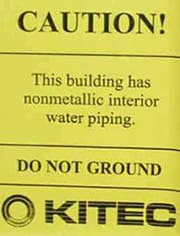Kitec is a polymer pipe that was typically installed in homes between 1995 and 2007. The issue with Kitec pipes is they are known to spontaneously burst, particularly on the hot water pipes. When Kitec pipes burst, it can cause extensive water damage to your home, including mold and mildew.
From the mid-1990s to 2007, Kitec was thought to be a cheaper alternative to copper piping. Recalls on Kitec piping began in 2005, about ten years after it became popular as a piping option. This implies that Kitec pipes may only last about ten years. Homes that have Kitec plumbing will likely experience increasingly more pipe failure as time goes on.
Kitec is Prone to Premature Failure
IPEX, the manufacturers of Kitec, claimed that it is resistant to corrosion, but in 2005 it was completely recalled because it does corrode much faster than many other piping options. There was a class action lawsuit, because the failure rate is so high that many homes sustained water damage.
Kitec piping tends to fail prematurely. This is not merely small leaks, the piping fails by bursting open. The hot water pipes and fittings are the most common failure points in the piping. Kitec pipes cannot sustain long term use with water above 177 F °. Excessive water pressure will also cause Kitec pipe failure. If the pipes burst, your home can sustain serious water damage, including flooding, mold, and mildew.
The Class Action Lawsuit
The manufacturer of Kitec, IPEX, denied there were issues with the piping, but a class action lawsuit was filed in the US and Canada. The pipes were recalled and $125 million dollars was awarded in a class action lawsuit.
The claim deadline was January 9, 2020. Claims submitted after this date will be rejected. The last payouts were made in 2023. This settlement was paid to homeowners in the US and Canada.
The plaintiffs claim that: ”the Kitec System is or may be defective because it could prematurely fail resulting in leaks or damage to the structure”.
Kitec pipes have two plastic layers separated by an aluminum layer. The fittings were made with too much zinc. Dezincification causes blockages in the lines, increasing the pressure in the piping, which causes the pipes to burst and crack.
How Can I Tell If I Have Kitec Plumbing?
Kitec plumbing is very distinct. The cold water pipes are bright blue, the hot water pipes are orange. Though less common, the piping may also be in gray and red.
The pipes will be labelled with one of these brand names:
- AmbioComfort
- AQUA
- KERR Controls
- Kitec
- IPEX
- Plomberie Amelioree
- PlumbBetter
- WarmRite
- XPA
Look for this piping near your hot water heater, utility room, garage, or wherever the piping is connected to your walls. Also look in your laundry room or under the sink in your kitchen and bathroom.
There will also be brass fittings labelled with one of these identifiers:
- ATSM F1974
- 9/10
- Kitec
- KTC

Lastly, there may be a yellow sticker inside your home’s electrical panel , indicating the pipes cannot be used as an electrical ground because they are non-metallic.
How Can You Tell if Your Kitec Plumbing is Failing?
There are two red flag warning signs to look for if your Kitec plumbing is about to fail.
- White reside is building up around the outside of the fittings.
- Your pipes are bulging or turning black.
If you see either of these signs, your Kitec plumbing is going to fail soon.
What Are Viable Options for Replacing Kitec Plumbing?
The two most reliable options for replacing Kitec are copper piping and PEX piping.
Copper piping is long-lasting, durable, and resistant to UV degradation. Copper pipes are usually covered by a 50 year limited warranty from the manufacturers. In most cases, American-made copper “L type” pipes will last up to 100 years. Copper pipes are also bacteriostatic, meaning the growth of bacteria in the pipes is inhibited. Lastly, home buyers like copper piping, so if you plan on selling your home in the future, copper piping is a good choice.
PEX piping has been used for water supplies in residential construction for about 15 years in the US. It has less fittings than copper piping, and is resistant to corrosion caused by alkaline water. The average lifespan of PEX piping is about 75 years.
Does Insurance Cover Kitec Replacement?
Some home insurance policies may cover Kitec replacement, but check with your policy underwriter.
How Much Does It Cost to Replace Kitec Plumbing?
The average home costs about $5,000 to $30,000 to repipe, for a one-to-three-bedroom house, including finish and paint. This is the going rate for homes in the Sacramento region.
Get a Quote on Repiping Your Home
If you have Kitec piping, or if you need your house repiped, Wise Monkey Repipe & Construction can repipe your home quickly and efficiently. We serve the Sacramento and Roseville area, including El Dorado Hills, Folsom, Rocklin, Lincoln, Woodland, Yuba City, and Stockton.
We also replace old galvanized steel piping with copper or PEX piping.
For a consultation or estimate, contact us or give us a call at (916) 304-7629.